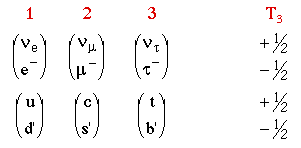
Physics 357 : 1998 Lecture 21
Generations and Weak Isospin
The weak interaction couples the fermions in pairs, and the pairs are usually described as belonging to different generations

The relative assignment of the quark and lepton generations is just according to their mass.
This two-state pairing is reminisent of the the two spin states allowed for a spin 1/2 fermion, or the 2 isospin states of a nucleon (proton and neutron), so we define all known fermions to have "weak isopin" 1/2, and the "up" type fermions are assigned T3=+1/2, and the "down" type fermions are assigned T3=-1/2.
Electroweak Theory
The group describing the spin states of a fermion is SU(2). So an SU(2) gauge theory is the "obvious" theory for the weak interaction. A gauge theory needs bosons to transform between all types of "charge" in the theory, i.e.
W+: T3=+1 {(T3=1/2) -> (T3=-1/2)}, e.g.

W-: T3=-1 {(T3=-1/2) -> (T3=1/2)}, e.g.

W0: T3=0 ·(+1/2-1/2)- (-1/2+1/2)Ò {(T3=±1/2) -> (T3=±1/2)}, e.g.

But if this is true, then why is the rate for

9 orders of magnitude smaller than

Glashow, Iliopoulos, and Maiani showed (in 1970, before charm was discovered) that Cabibbo mixing along with the existence a charmed quark solves this problem. (See F&H equation 13.10.)
The W0 has the same quantum numbers as the photon, so mixing occurs leading to a unified electroweak theory.
Pure SU(2)L Bosons (Weak Isospin=1)
Pure U(1) Boson (Weak Isospin=0)
The actual observed bosons are the g and the Z0.
Both the Z0 and the g are part SU(2) and part U(1) gauge bosons, so the coupling of the Z0 depends on both the electric charge and the T3 of the fermions. i.e. The coupling of the Z0 to "up" type quarks is different from the coupling to "down" type quarks, which is different from charged leptons, which is different from neutrinos.
Both the Z0 and the g couple only fermions to themselves.
e.g. Only

Never

Predictions of electroweak theory
e.g. (F&H equations 13.42, 13.43)

Neutral currents discovered 1973 at CERN.

The W & Z were discovered in 1982 at CERN.
or else the b quark will not have full weak coupling
The top quark was discovered in 1994 by the CDF experiment at Fermilab.
Some questions about electroweak gauge theory:
Return to List of Lecture Notes